Queer Places:
Ardgillan Castle, Ardgillan Demesne, Skerries, Co. Dublin, K34 C984 Ireland
Kensal Green Cemetery, Harrow Rd, London NW10 5JU, UK
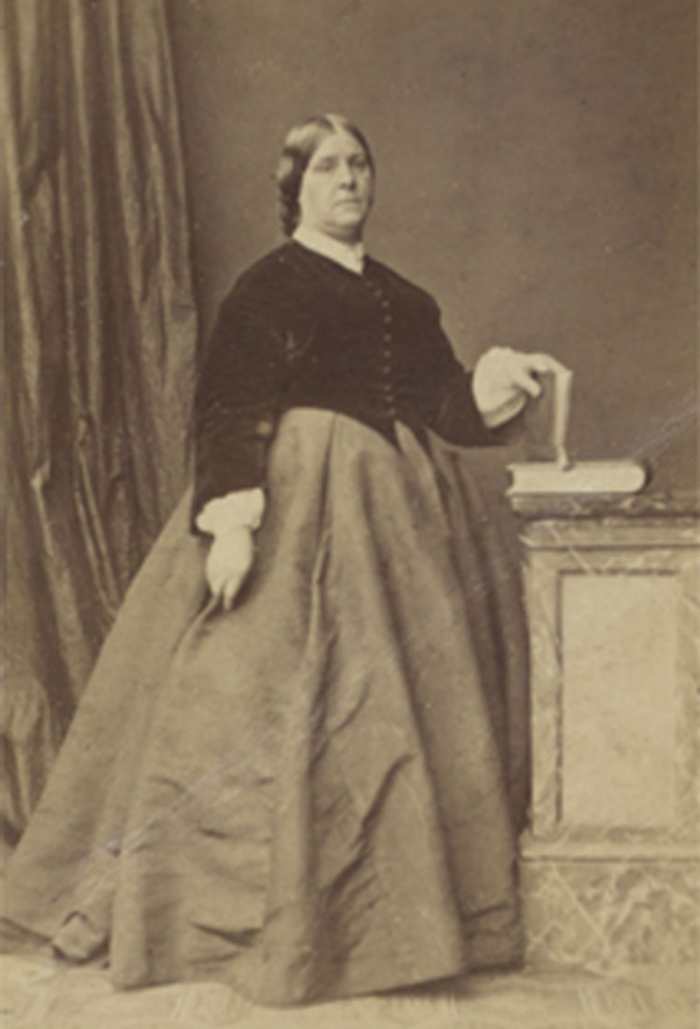 Frances Anne "Fanny" Kemble (27 November 1809 – 15 January 1893) was
a notable British actress from a
theatre family in the early and mid-19th century. She was a well-known and
popular writer, whose published works included plays, poetry, eleven volumes
of memoirs,
travel writing and works about the theatre. She was part of a group of expatriate, largely English-speaking women
which included poet Elizabeth Barrett Browning, actors
Charlotte Cushman and
Harriet
Hosmer, mathematician and astronomer
Mary Somerville, inventor
Natalie Micas, painter
Rosa Bonheur, journalist
Matilda Hays, sculptor
Mary Lloyd, journalist and social reformer
Frances Power Cobbe, and others. They were part of an informal organisation of
like-minded women who shared ideas and lives that would later in the
century be called feminist.
Frances Anne "Fanny" Kemble (27 November 1809 – 15 January 1893) was
a notable British actress from a
theatre family in the early and mid-19th century. She was a well-known and
popular writer, whose published works included plays, poetry, eleven volumes
of memoirs,
travel writing and works about the theatre. She was part of a group of expatriate, largely English-speaking women
which included poet Elizabeth Barrett Browning, actors
Charlotte Cushman and
Harriet
Hosmer, mathematician and astronomer
Mary Somerville, inventor
Natalie Micas, painter
Rosa Bonheur, journalist
Matilda Hays, sculptor
Mary Lloyd, journalist and social reformer
Frances Power Cobbe, and others. They were part of an informal organisation of
like-minded women who shared ideas and lives that would later in the
century be called feminist.
Fanny Kemble's address, O Lesbian, to the long dead Sappho, became an
address to lesbians today - O Lesbian, a apostrophic call to a people no
longer absent, dead, or mythic. O Lesbian, the call to share in dialogue. O
Lesbian, still a contested formation; O Lesbian, the apostrophic motion to
animate a people. While Victorian predecessors wrote verse about Sappho and
the tragedy of her love which plunged her into the depths of the sea that was
death, lesbian poets today actually are fulfilling the final intimation of
Fanny Kemble, " 'Tis more than death - 'tis all of life - And parcel of
Eternity."
One of Kemble's special friends was Harriet St. Leger (1795-1878). Harriet St. Leger was unlike any other woman Fanny Kemble had ever met. A member of a reclusive Anglo-Irish country family, she lived at Ardgillan Castle, a fine eighteenth-century manor house set close to the cliffs about fifteen miles north of Dublin.
The daughter of the Hon. Richard St. Leger and a granddaughter of Viscount Doneraile of County Cork, she had lived at the castle for some fifteen years with her sister Marianne and Marianne's husband, a Church of Ireland cleric, at the time of meeting Kemble. Harriet was tall, angular, and athletic, with cropped chestnut hair and fine gray eyes, and eccentric in many things, none more so than in her clothes. Dressed in men's hats and boots especially made for her in London, beautifully cut black and gray cashmere dresses, trim-fitting short waistcoats, and immaculate collars and cuffs, she looked like an androgynous and beautiful young man. To Kemble, she was a modern Atalanta or Diana, the Greek mythology wood goddesses known for hunting and aversion to marriage. To Frances Power Cobbe, the prominent Victorian antivivisectionist and intellectual, who grew up not far from Ardgillan Castle, she was "a deep and singularly critical thinker and reader [who] had one of the warmest hearts which ever beat under a cold and shy exterior." Cobbe adds that Harriet's fondness for male clothing (especially black beaver hats) made her as peculiar in the eyes of her neighbors as the notorious Ladies of Llangollen were in theirs—Lady
Eleanor Butler and Miss
Sarah Ponsonby, learned and literary Regency women who were renowned for living openly as a lesbian couple' According to Cobb; "All the empty-headed men and women in the county prated incessantly" about Harriet's "offensive garments."'
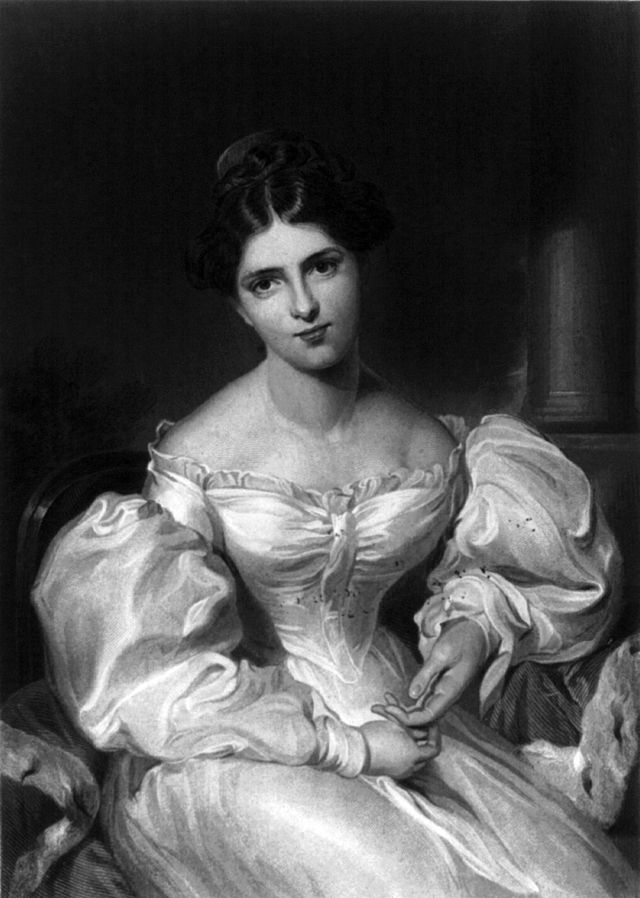
Fanny Kemble
by Sir Thomas Lawrence

Fanny Kemble
after Sir Thomas Lawrence
hand-coloured lithograph, 1830s
NPG D5156

Fanny Kemble
by Jean Gigoux, printed by Lemercier, after Sir Thomas Lawrence
hand-coloured lithograph, 1830
NPG D5159
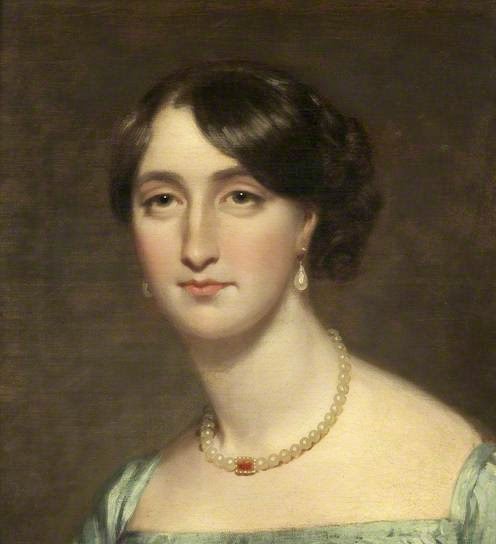.jpg)
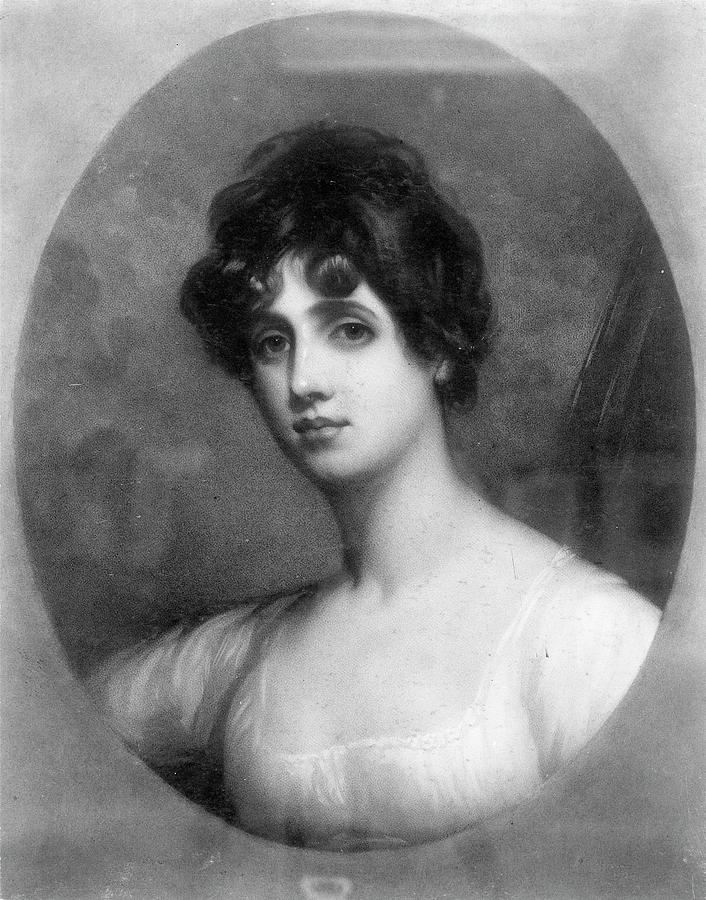


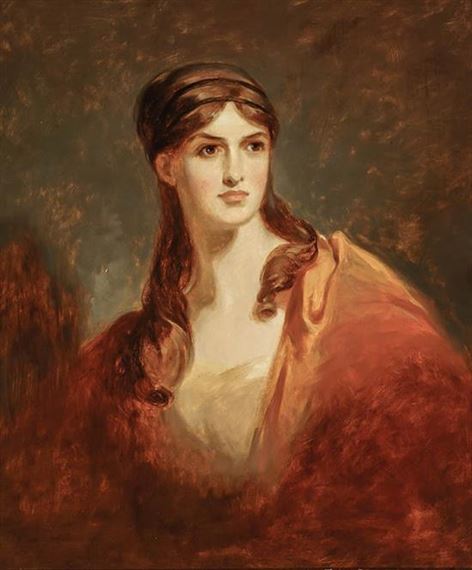


Fanny Kemble
by Peter Frederick Rothermel
oil on canvas, 1849
NPG 5462
A member of the famous Kemble theatrical family, Fanny was the eldest
daughter of the actor
Charles Kemble and his
Viennese-born
wife, the former
Marie Therese De Camp. She was a niece of the noted tragedienne
Sarah Siddons and of the famous actor
John Philip Kemble. Her younger sister was the opera singer
Adelaide Kemble.[2]
Fanny was born in London and educated chiefly in France. In 1821, Fanny Kemble departed to boarding school
in Paris to study art and music as befitted the child of, at the time, the
most celebrated artistic family in England. In addition to literature and
society, it was at Mrs. Lamb’s Academy in the Rue d’Angoulême, Champs Elysées,
that Fanny received her first real personal exposure to the stage performing
staged readings for students’ parents during her time at school. As an
adolescent, Kemble spent time studying literature and poetry, in particular
the work of Lord Byron.[3]
One of her teachers was Frances Arabella Rowden (1774-1840?)[4],
who had been associated with the
Reading Abbey Girls' School since she was 16. Rowden was an engaging
teacher, with a particular enthusiasm for the theatre. She was not only a
poet, but, according to
Mary Russell Mitford, "she had a knack of making poetesses of her pupils"[5]
In 1827, Kemble wrote her first five-act play, Francis the First. It
was met with critical acclaim from multiple quarters. Nineteenth century
critics wrote of the script: “…it displays so much spirit and originality, so
much of the true qualities which are required in dramatic composition, that it
may fairly stand upon its own intrinsic worth, and that the author may
fearlessly challenge a comparison with any other modern dramatist.”
[6]
On 26 October 1829, at the age of 20, Kemble first appeared on the stage as
Juliet in
Romeo and Juliet at
Covent Garden Theatre after only three weeks of rehearsal time. Her
attractive personality at once made her a great favourite, and her popularity
enabled her father to recoup his losses as a
manager. She played all the principal women's roles of the time, notably
Shakespeare's
Portia and Beatrice (Much
Ado about Nothing), and
Lady Teazle in
Richard Brinsley Sheridan's
The School for Scandal.[7][8].
Kemble disliked the artificiality of stardom in general, but appreciated the
salary which she accepted to help her family which was often in financial
trouble.
In 1832, Kemble accompanied her father on a theatrical tour of the United
States. While in Boston in 1833, she journeyed to
Quincy to witness the revolutionary technology of the first commercial
railroad in the United States. She had previously accompanied George
Stephenson on a test of the L&M prior to its opening in England and described
the tests in a letter written in early 1830. The
Granite Railway was among many sights which she recorded in her journal.
In 1834, Kemble retired from the stage to marry an American on 7 June,
Pierce Mease Butler, whom she had met on an American acting tour with her
father in 1832.[2]
Although they met and lived in Philadelphia, Butler was the grandson of
Pierce Butler, a
Founding Father, and heir to a large fortune in cotton, tobacco, and rice
plantations. By the time the couple's daughters, Sarah and Frances, were born,
Butler had inherited three of his grandfather's plantations on Butler Island,
just south of Darien, Georgia, and the hundreds of people who were enslaved on
them. After living in Philadelphia for a time, Butler became heir to the
cotton, tobacco and rice plantations of his grandfather on Butler Island, just
south of Darien, Georgia, and to the hundreds of slaves who worked them. He
made trips to the plantations during the early years of their marriage, but
never took Kemble or their children with him.
In the 1840s and 1850s, the Berkshire town served as a cultural center for
Boston-based writers and intellectuals, including
Herman Melville,
Oliver Wendell Holmes,
Henry Ward Beecher, and
Nathaniel Hawthorne. It was also a magnet for an
international coterie of progressive women reformers, among them
Frances Ann
(Fanny) Kemble, the British actress turned abolitionist;
Harriet Martineau,
the British writer on women’s rights; Fredrika Bremer, the Finnish feminist;
and Anna Jameson, the
British feminist and historian—all of whom engaged the young minds at the
Elizabeth Sedgwick’s Lenox Academy, a progressive boarding school in the
Berkshires for audacious girls. At
Catharine Sedgwick’s
invitation, Kemble first visited Lenox in 1838. In her youth, Kemble had
inherited the mantle of her famous thespian aunt, Sarah Siddons. A reluctant
performer, she pursued a theatrical career for a short time before marrying
the Southern American aristocrat Pierce Butler and retiring from the stage in
1834. The marriage proved disastrous; the couple became estranged in 1842 and
finally divorced in 1849, at which time she settled in Lenox. Characterizing
her “sisterhood” with Kemble in the strongest of terms, Sedgwick wrote: “I do
not believe that men can ever feel so pure an enthusiasm for women as we can
feel for one another—ours is nearest to the love of angels.” In Lenox,
Sedgwick, Kemble, and the young Hosmer formed a close bond. A few years later,
Hosmer would attribute her decision to pursue a sculptural career to her
friendship with Kemble.
Demonstrating an intrepid independence, Kemble became Lenox’s most
conspicuous resident. She caused quite a stir by adopting the revolutionary
dress of pantaloons, thus participating in the short-lived yet quite radical
Dress Reform Movement promoted by Amelia Bloomer. Kemble loved to ride her horse through the countryside,
her riding habit consisting of a black velvet jacket and cap and a wide white
riding skirt with man’s trousers beneath. Writing in the journal the Lily,
Bloomer noted that “male attire” had become prevalent among certain women in
Lenox: “Several ladies of Lenox with Mrs. Kemble at their head, had actually
paraded the streets, equipped in coats, vests and pantaloons, and all the
other paraphernalia of a gentlemen’s dress.”
At Kemble's insistence, the family spent the winter of 1838–39
there and Kemble kept a diary of her observations, flavored strongly by the
abolitionist sentiment. Kemble was shocked by the living and working conditions of the
slaves and
their treatment at the hands of the overseers and managers. She tried to
improve conditions and complained to her husband about
slavery, and about the
mixed-race slave children attributed to the overseer, Roswell King, Jr.
When the family returned to Philadelphia in the spring of 1839, Kemble and
her husband were suffering marital tensions. In addition to their
disagreements over treatment of the slave families at Butler's plantations,
Kemble was "embittered and embarrassed" by Butler's marital infidelities.[10]
Butler threatened to deny Kemble access to their daughters if she published
any of her observations about the plantations.[11]
By 1845-7, the marriage had failed irretrievably, and Kemble returned to
Europe.[2]
Butler disapproved of Kemble's outspokenness, forbidding her to publish.
The relationship grew abusive, and Kemble eventually went back to England with
her two daughters. Butler filed for a divorce in 1847, after they had been
separated for some time, citing abandonment and misdeed by Kemble.[1]
In 1847, Kemble returned to the stage in the United States, as she needed
to make a living following her separation. Following her father's example, she
appeared with much success as a Shakespearean reader rather than acting in
plays. She toured the United States. The couple endured a bitter and
protracted divorce in 1849, with Butler retaining custody of their two
daughters. At that time, with divorce rare, the father was customarily awarded
custody in the patriarchal society. Other than brief visitations, Kemble was
not reunited with her daughters until each came of age at 21.[12]
Kemble returned to her acting career as a solo platform performer beginning
her first American tour in 1849. During her readings she rose
to focus her work on the presentation of edited works of Shakespeare, although
unlike others she insisted on providing a representation of his entire canon,
ultimately building her repertoire to twenty-five of his plays.
Fanny Kemble’s sister, Adelaide
Sartoris, who had lived in Rome for two years, led a salon on Wednesday
and Sunday nights in her apartment atop the Spanish Steps. Trained as an opera
singer, she performed regularly at these cosmopolitan gatherings, which
Harriet Hosmer attended with regularity.
Kemble soon followed her sister to Rome, arriving in January of 1853. Hosmer,
enamored with the city and its community of independent women, wrote that the
two Kemble sisters were “like two mothers to me.”
Charlotte Cushman held her
first reception in her new home in January of 1859, beginning a tradition that
would continue for many years. Mingling at this festive event were the
feminist art historian Anna Jameson, Fanny Kemble,
Adelaide Sartoris, and the British author and reformer
Mary Howitt, to name just a few. When the Irish feminist
Frances Power Cobbe came to town, she noted: There was a brightness, freedom and joyousness among these gifted Americans, which was quite delightful to me. Cushman had the gift of drawing out the best from all who came, explained
Emma Crow, the youngest daughter of the philanthropist Wayman Crow.
Fanny Kemble's ex-husband squandered a fortune estimated at $700,000. He was saved
from bankruptcy by his sale on 2–3 March 1859 of the 436 people he held in
slavery.
The Great Slave Auction, at Ten Broeck racetrack outside
Savannah, Georgia, was the largest single slave auction in United States
history. As such, it was covered by national reporters.[13]
She returned to the theatre and toured major US cities, giving successful
readings of Shakespeare plays. Her memoir circulated in
American abolitionist circles, but she waited until 1863, during the
American Civil War, to publish her anti-slavery
Journal of a Residence on a Georgian Plantation in 1838-1839.[2]
It has become her best-known work in the United States: she published several
other volumes of journals.
Following the
American Civil War, Butler tried to run his plantations with free labour,
but he could not make a profit. He died of
malaria in
Georgia in 1867. Neither Butler nor Kemble ever remarried.[14]
She performed in both Britain and the United States, concluding her career
as a platform performer in 1868.[9]
Her older daughter, Sarah Butler, married Owen Jones Wister, an American
doctor. They had one child,
Owen
Wister, who grew up to become a popular American novelist, writing the
popular 1902 western novel
The Virginian. Fanny's other daughter Frances met James Leigh in
Georgia. He was a
minister born in England. The couple married in 1871. Their one child,
Alice Leigh, was born in 1874. They tried to operate Frances' father's plantations with free labour, but
could not make a profit. Leaving Georgia in 1877, they moved permanently to
England. Frances Butler Leigh defended her father in the continuing postwar
dispute over slavery as an institution. Based on her experience, Leigh
publishedd Ten Years on a Georgian Plantation since the Warr(1883), a
rebuttal to her mother's account..
[18]]
Kemble's success as a Shakespearean reader enabled her to buy a home in
Lenox, Massachusetts.[15]
In 1877, Kemble returned to London to join her younger daughter Frances, who
had moved there with her British husband and child. Kemble used her maiden
name and lived there until her death. During this period, she was a prominent
and popular figure in London society. She became a great friend of the
American writer
Henry
James during her later years. His novel,
Washington Square (1880), was based upon a story Kemble had told him
concerning one of her relatives.[16]
Kemble openly discussed Frances
Power Cobbe and Mary Lloyd as a couple.
In an 1877 letter to Harriet St. Leger, published in 1890,
Kemble mused: “I think Mary Lloyd really suffers from London; nevertheless not
half so much as Fanny would from living out of it. They talk of going away,
but . . . I think they are likely to be here for some time yet.” Kemble rented
a house formerly occupied by Lloyd and Cobbe, and whether writing of how Cobbe
had to cancel engagements when Lloyd got lumbago, mentioning that “Fanny Cobbe
and Mary Lloyd are coming to lunch with me on Monday,” or casually referring
to “them,” “they,” and “their” when Cobbe was her primary subject, she took it
for granted that the women were a conjugal unit. Kemble’s vision of the
relationship corresponded to Cobbe’s, who recalled “falling fast asleep while
[Fanny Kemble] was reading Shakespeare to Mary Lloyd and me in our
drawing-room” and whose own autobiography was peppered with references to
“us,” “our house,” and “our neighbors.”
In her Records of Girlhood (1879), Fanny Kemble recalled two sisters with
“beautiful figures as well as faces” who wore dresses “low on the shoulders
and bosom” and wrote of one, “I remember wishing it were consistent with her
comfort and the general decorum of modern manners that Isabella Forrester’s
gown could only slip entirely off her exquisite bust.”
My published books:


BACK TO HOME PAGE

- https://en.wikipedia.org/wiki/Fanny_Kemble
- Queers in American Popular Culture, Volume 2
by
Jim Elledge
ABC-CLIO, 2010 - Social Science - 945 pages
- Fanny Kemble: A Performed Life
by
Deirdre David
University of Pennsylvania Press, Feb 12, 2013 - Biography & Autobiography - 376 pages
- Marcus, Sharon. Between Women (pp.51-52). Princeton University Press.
Edizione del Kindle.
- Dabakis, Melissa. A Sisterhood of Sculptors . Penn State University
Press. Edizione del Kindle.
 Frances Anne "Fanny" Kemble (27 November 1809 – 15 January 1893) was
a notable British actress from a
theatre family in the early and mid-19th century. She was a well-known and
popular writer, whose published works included plays, poetry, eleven volumes
of memoirs,
travel writing and works about the theatre. She was part of a group of expatriate, largely English-speaking women
which included poet Elizabeth Barrett Browning, actors
Charlotte Cushman and
Harriet
Hosmer, mathematician and astronomer
Mary Somerville, inventor
Natalie Micas, painter
Rosa Bonheur, journalist
Matilda Hays, sculptor
Mary Lloyd, journalist and social reformer
Frances Power Cobbe, and others. They were part of an informal organisation of
like-minded women who shared ideas and lives that would later in the
century be called feminist.
Frances Anne "Fanny" Kemble (27 November 1809 – 15 January 1893) was
a notable British actress from a
theatre family in the early and mid-19th century. She was a well-known and
popular writer, whose published works included plays, poetry, eleven volumes
of memoirs,
travel writing and works about the theatre. She was part of a group of expatriate, largely English-speaking women
which included poet Elizabeth Barrett Browning, actors
Charlotte Cushman and
Harriet
Hosmer, mathematician and astronomer
Mary Somerville, inventor
Natalie Micas, painter
Rosa Bonheur, journalist
Matilda Hays, sculptor
Mary Lloyd, journalist and social reformer
Frances Power Cobbe, and others. They were part of an informal organisation of
like-minded women who shared ideas and lives that would later in the
century be called feminist.


.jpg)







